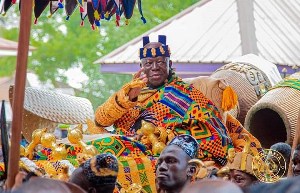General News of Tuesday, 20 August 2013
Source: radioxyzonline
Supreme Court must speak with one voice - Law Prof.
Ghanaian Law Professor, H. Kwasi Prempeh, says it is imperative Ghana’s Supreme Court speaks with a united voice as far as its anticipated verdict on the election petition is concerned.
In an article, the Setion Hall University Law School Professor in Newark, New Jersey, U.S.A., said a split decision will not augur well for the nine-member Supreme Court Bench as far as suspicions about their political leanings are concerned.
He said, inasmuch as the margin of victory will be legally inconsequential, the political interpretations thereof, cannot be glossed over.
“Legally, of course, it matters not whether the decision of the Supreme Court is 9-0, 8-1, 7-2, 6-3, or 5-4; the LEGAL effect is the same. Legally speaking, “all win be win”; the margin of “victory” does not matter. But it is not the legal effect of the Court’s decision that concerns me here. Interested as I am in what the Court’s decision might mean for the standing and legitimacy of the Supreme Court and for the peace and unity of the nation, it is the POLITICAL, not the legal, effect of how the nine Justices line up behind the Court’s decision that concerns me here,” he explained.
The founding member of Ghana’s Centre for Democratic Development (CDD) noted that: “A 5-4 decision would be especially inauspicious for the unity and healing of our politically fractured country and the standing of the Court if the split or division on the Court corresponds to widely perceived notions of the partisan or subjective preferences of the Justices in relation to the parties in dispute”.
He, therefore, counsels the Court, in making its decision, to consider the prospective legal and political ramifications and consequences of a decision by a “united court” as against that of a “sharply divided” Bench.
Prof. Prempeh has, therefore, advised Ghana’s Supreme Court to borrow a limb from “the landmark U.S. case of Brown v. Board of Education of Topeka, Kansas (1954), in which the U.S. Supreme Court, led by then Chief Justice Earl Warren, declared racial segregation in American public education (and, by extension, in public programs and facilities generally) unconstitutional”.
He said the then Chief Justice, cognisant of the political and racial consequences that a seemingly divided or disunited decision by the Bench could have on a North-South divided America, resolved to rally the only dissenter on the Bench to join the majority eight Justices to speak with one voice.
Below is the full article of Prof. H. Kwasi Prempeh
Will the Ghana Supreme Court Seize its "Brown" Moment or End Up a Badly Divided Court?
As the scheduled August 29, 2013 date for the Supreme Court’s ruling in the Presidential Petition case approaches, there is growing anxiety among Ghanaians concerning the likely reaction of partisans or “foot soldiers” of the NPP and NDC to the decision of the Court. Concerns that the Court’s decision, whichever way it goes, would be met with widespread socially disruptive behavior from partisans of the two rival parties have elicited a chorus of peace appeals from various civic organizations as well as assurances and warnings of readiness from the security agencies. While the two rival political parties and their supporters are generally considered to hold the key to peace or disorder in the aftermath of the August 29 ruling, it is the Supreme Court that I would like to focus on here.
Although much of the public anticipation has centered on “what” the Court’s decision would be, in the narrow sense of which one of the rival litigants will prevail in the end, my present interest is not so much WHICH WAY the Court would decide as HOW. In my view, the greatest contribution the Supreme Court can make to its own legitimacy and to the unity and peace of the country is in HOW it decides this case—even more so than which party to the suit it declares as “winner” or “loser”. The “how” issue is two-fold. First is the technical quality and legal soundness of the written judgment the Court eventually delivers in this case. A well-crafted judicial opinion, rooted in sound exposition, analysis, and application of the law to the facts yet delivered not in verbose legalese but in plain and clear language addressed to the nation at large, is the sort of decision this case demands of the Court. The second issue is whether the decision the Court hands down on August 29, 2013 will be the decision of a “unified” court or a “divided” court. While both aspects of the Court’s eventual decision are important, I am more concerned here with the second.
Legally, of course, it matters not whether the decision of the Supreme Court is 9-0, 8-1, 7-2, 6-3, or 5-4; the LEGAL effect is the same. Legally speaking, “all win be win”; the margin of “victory” does not matter. But it is not the legal effect of the Court’s decision that concerns me here. Interested as I am in what the Court’s decision might mean for the standing and legitimacy of the Supreme Court and for the peace and unity of the nation, it is the POLITICAL, not the legal, effect of how the nine Justices line up behind the Court’s decision that concerns me here.
Politically, as opposed to legally, it does matter a great deal whether the decision of the Court on August 29 is the decision of a “unified court” or a sharply “divided” court. By a “unified” court, I mean here a court that speaks, as nearly as possible, with a single voice. A unanimous court (9-0) is, of course, the best example of a unified court; though, arguably, an 8-1 or a 7-2 outcome would appear to meet the minimum criteria as well. In short, a decision of the Court that is supported by all or the overwhelming majority of the Justices is to be preferred, politically, to a decision that is backed by a bare majority of the Court (5-4). A 5-4 decision would be especially inauspicious for the unity and healing of our politically fractured country and the standing of the Court if the split or division on the Court corresponds to widely perceived notions of the partisan or subjective preferences of the Justices in relation to the parties in dispute.
It is for this reason that I think the Ghana Supreme Court should consider this case a “Brown” moment. I am referring to the landmark U.S. case of Brown v. Board of Education of Topeka, Kansas (1954), in which the U.S. Supreme Court, led by then Chief Justice Earl Warren, declared racial segregation in American public education (and, by extension, in public programs and facilities generally) unconstitutional. Although Chief Justice Warren knew he had a majority of his fellow Justices with him in believing that the time had come to deny judicial sanction to the longstanding practice of official racial segregation in America, he was not content to decide the case with just a majority of the Justices on his side. He wanted a unanimous Court: a Supreme Court that would speak with a single voice on this most divisive national issue and whose voice would thus send an unequivocal, uncompromising message to the defenders of the status quo, primarily in the American South, that the days of official segregation were irretrievably over.
Anticipating Southern political resistance to the Court’s decision and mindful of the South's longstanding feeling of "Yankee" self-righteousness in matters of "race relations", Chief Justice Warren was particularly careful to ensure that the Court’s Justices did not split along a Northern/Southern axis, with the Court’s Northern majority in favor of judicial abolition of racial segregation while the Court’s Southern justice(s) dissented. Thus, when it appeared that the Court’s likely lone dissenter would be one of the Justices from the South, Chief Justice Warren focused his energies on getting him to abandon his opposition and side with the court’s majority.
Chief Justice Warren did not want either a dissenting or a concurring opinion; he wanted all of the Court’s nine Justices to sign on to a single authoritative Opinion of the Court. And that, in the end, is what he got. Judicial unanimity did not, of course, forestall Southern resistance when the Court’s decision was eventually handed down. But what the “blowout” 9-0 decision of the U.S. Supreme Court in Brown v. Board of Education did was deprive the forces of reaction and resistance in the American South of an ally on the Court whose dissenting opinion they could use in their counter-mobilization or to portray the Court as partisan. The story of how Chief Justice Warren orchestrated that masterful and politically significant consensus on the Court has been recounted in several works of legal history and judicial biography. It is also recounted, with brevity, in the companion article I have posted on my Facebook wall.
There are, of course, no factual or doctrinal parallels between the Brown case and Ghana’s Presidential Petition case; one concerned the constitutionality of racial segregation, the other the validity of a presidential election. In the contemporary Ghanaian context, however, the challenge before the Supreme Court is no less historic or momentous and demands of the Justices equally exceptional judicial statesmanship. It is, therefore, my hope that on August 29, 2013 the Ghana Supreme Court will seize its “Brown” moment and give the people of Ghana a well-crafted, legally sound decision that stands in the name of a unified court.
Entertainment










